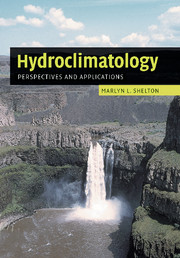Book contents
- Frontmatter
- Contents
- Preface
- 1 The realm of hydroclimatology
- 2 The climate system and the hydrologic cycle
- 3 Measuring hydroclimate atmospheric components
- 4 Measuring hydroclimate terrestrial components
- 5 Remote sensing and hydroclimate data
- 6 The runoff process and streamflow
- 7 Hydroclimate spatial variations
- 8 Hydroclimate temporal variations
- 9 Floods: the hydroclimatic extreme of excessive moisture
- 10 Drought: the hydroclimatic extreme of deficient moisture
- References
- Index
3 - Measuring hydroclimate atmospheric components
Published online by Cambridge University Press: 06 July 2010
- Frontmatter
- Contents
- Preface
- 1 The realm of hydroclimatology
- 2 The climate system and the hydrologic cycle
- 3 Measuring hydroclimate atmospheric components
- 4 Measuring hydroclimate terrestrial components
- 5 Remote sensing and hydroclimate data
- 6 The runoff process and streamflow
- 7 Hydroclimate spatial variations
- 8 Hydroclimate temporal variations
- 9 Floods: the hydroclimatic extreme of excessive moisture
- 10 Drought: the hydroclimatic extreme of deficient moisture
- References
- Index
Summary
An atmospheric focus
The relationship between climate of the first kind and the atmospheric branch of the hydrologic cycle presented in Chapter 1 emphasizes atmospheric transport and mobility as central characteristics of these concepts. The atmosphere's radiative properties are important in determining energy exchanges within the atmosphere and between the Earth's surface and the atmosphere. Resulting radiation variations account for the gradient of radiant energy that provides the potential energy for horizontal and vertical atmospheric motion. Vast quantities of water are continuously in motion in the climate system conditioned by water vapor sources and sinks in the atmosphere (Peixoto, 1995). The dynamics of global atmospheric circulation revealed by its state variables are a logical starting point for observing the transport of energy and moisture inherent to climate of the first kind and the atmospheric branch of the hydrologic cycle.
It is convenient to portray the general condition of the atmosphere as a thermodynamic-hydrodynamic system. It can be characterized by its composition, its thermodynamic state as specified by the three thermodynamic variables, pressure, temperature, and humidity, and its three-dimensional motion field. Precipitation, evaporation, and runoff are fluxes and not state variables even though they are intimately connected with the state of the atmosphere (Peixoto and Oort, 1992). These flux variables that couple the atmospheric and terrestrial phases of climate and the hydrologic cycle are discussed in Chapter 4 in the context of climate of the second kind and the terrestrial branch of the hydrologic cycle.
- Type
- Chapter
- Information
- HydroclimatologyPerspectives and Applications, pp. 55 - 73Publisher: Cambridge University PressPrint publication year: 2008



